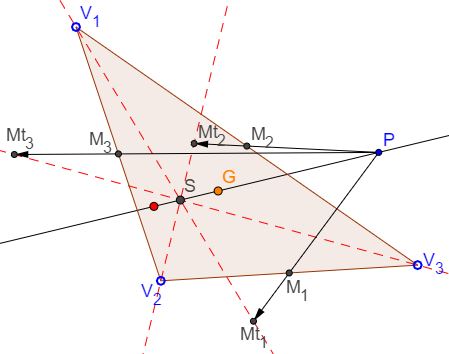A Characterization of the Euler Line
The applet below illustrates a view point on problem 1814 from the Mathematics Magazine. The problem has been proposed by Michael Goldenberg and Mark Kaplan, The Ingenuity Project, Baltimore Polytechnic Institute, Baltimore, MD. A solution by Herb Beiley, Rose Hulman Institute of Technology, Terre Haute, IN, has been published in Vol 83 (2010), No 1, pp 68-69.
Let $V_{1}V_{2}V_{3}$ be a triangle with circumcenter $O,$ and let $M_{1}, M_{2}, M_{3}$ be the midpoints of $V_{2}V_{3},$ $V_{1}V_{3},$ and $V_{1}V_{2},$ respectively. For $-\infty \lt t \le \infty $ and $k = 1, 2, 3,$ let $Mt_{k}$ be the point defined by $OMt_{k}$ = $tOM_{k},$ (where by $Mt_{\infty }$ we mean the point at infinity in the direction of $OM_{k}.)$ Prove that for any $t\in (-\infty , \infty ],$ the lines $V_{k}Mt_{k},$ $k = 1, 2, 3,$ are concurrent, and that the locus of all such points of concurrence is the Euler Line of $\Delta V_{1}V_{2}V_{3}.$

I do not remember being so disappointed on reading a problem or a solution in the Mathematics Magazine. Compared to the American Mathematical Monthly (both published by the Mathematical Association of America), the Mathematics Magazine is intended to a broader audience that may include high school math teachers or even students. But then its editors have probably even greater responsibility to avoid publishing tasteless exercise disguised as a piece of mathematics.
My contention is that the problem's setup has actually very little to do with the Euler line. A little generalization shows that this is indeed so:
Observe that for $P = O,$ the circumcenter of $V_{1}V_{2}V_{3},$ the latter formulation reduces to that of the original problem because the Euler line passes through both $G$ and $O.$ (The applet actually illustrates the generalization.)
The published solution replaces the problem with the following one:
Let $P$ be a point on the perpendicular bisector of side $V_{1}V_{2}$ and let $Mt_{k}$ be the point defined by $PMt_{k} = tPM_{k}.$ Then lines $V_{k}Mt_{k}$, $k = 1, 2, 3,$ are concurrent, and that the locus of all such points of concurrence is a line. The line is the Euler Line if and only if $P$ is chosen to be the circumcenter.
I loath to reproduce the whole proof. The idea is to choose the coordinate system with $O$ at the center and the base of the triangle symmetric in the $y$-axis. Such selection simplifies the analytic algebra that follows.
Now observe that both formulations are somewhat loose in defining $Mt_{k}.$ The confusion here is between affine (consisting of points) and vector spaces. By itself, say, $OMt_{k}$ = $tOM_{k}$ define a vector, not a point. The intention is apparently to the point $Mt_{k} = O + t(M_{k} - O).$ I never before saw it defined otherwise. I may be old-fashioned of course.
So let's proof the following statement:
Let $P$ be a point in the plane of $\Delta V_{1}V_{2}V_{3},$ and let $M_{1}, M_{2}, M_{3}$ be the midpoints of $V_{2}V_{3},$ $V_{1}V_{3},$ and $V_{1}V_{2},$ respectively. For $-\infty \lt t \le \infty $ and $k = 1, 2, 3,$ let $Mt_{k}$ be the point defined by $Mt_{k} = P + t(M_{k} - P),$ (where by $Mt_{\infty }$ we mean the point at infinity in the direction of $PM_{k}.)$ Prove that for any $t\in (-\infty , \infty ],$ the lines $V_{k}Mt_{k},$ $k = 1, 2, 3,$ are concurrent, and that the locus of all such points of concurrence is the line $GP$ where $G$ is the centroid of $ \Delta V_{1}V_{2}V_{3}.$
Note that, for a fixed $t,$ function $F_{t}(M)$ = $P + t(M - P)$ is a homothety transformation with center $P$ and coefficient $t.$ This homothety maps $M_{k}$ onto $Mt_{k},$ $k = 1, 2, 3,$ and the whole $\Delta M_{1}M_{2}M_{3}$ onto $\Delta Mt_{1}Mt_{2}Mt_{3}.$ Note also, that $\Delta M_{1}M_{2}M_{3}$ is also a homothetic image of $\Delta V_{1}V_{2}V_{3}.$ In this case, the homothety, say, $F$ has center $G$ and coefficient $-1/2.$
It follows that $\Delta Mt_{1}Mt_{2}Mt_{3}$ is obtained from $\Delta V_{1}V_{2}V_{3}$ by a product (successive application) of two homotheties. Such a product is also a homothety (unless it is a translation) with center on the line joining the centers of the two homotheties, $F$ and $F_{t},$ i.e., $G$ and $P.$ (The proof of this result is not difficult. It is well illustrated by the three circles theorem.)
Thus for every $t,$ the center of homothety that maps $\Delta V_{1}V_{2}V_{3}$ onto $\Delta Mt_{1}Mt_{2}Mt_{3}$ is on line $PG.$ But this homothety maps $V_{k}$ onto $Mt_{k}$ so that line $V_{k}Mt_{k}$ passes through the center of homothety, meaning that this is where the three lines $V_{k}Mt_{k},$ $k = 1, 2, 3,$ concur.
$PG$ becomes the Euler line for any $P$ on $GO.$
|Activities| |Contact| |Front page| |Contents| |Geometry|
Copyright © 1996-2018 Alexander Bogomolny
73573437
